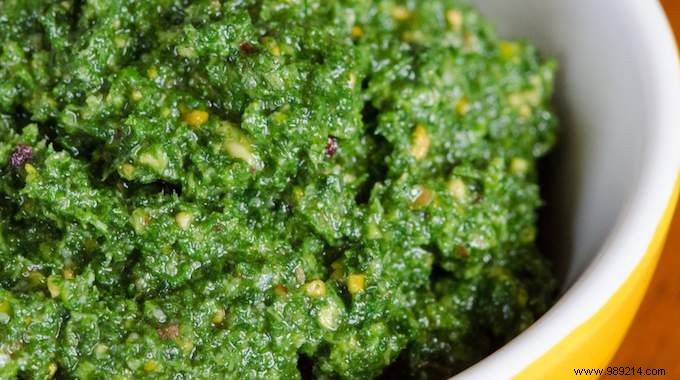
In general, we don't really like nettles.
They sting and tend to invade the garden.
But did you know that these wild plants are edible?
Yes, the basil pesto is delicious. In addition, it has the merit of being original!
So why not take advantage of a stroll on these beautiful spring days to bring back something to make a tasty nettle pesto?
Do not worry. It's super simple to do. I explain how to prepare it.

- 3 tablespoons of oil (olive or walnut)
- 2 garlic cloves, roughly chopped
- the juice of a lemon
- a pinch of salt and a pinch of pepper
- a small handful of roughly chopped hazelnuts
- About 50 to 60 g of nettle leaves picked in the forest
1. Take a good pair of gloves.
2. Choose the 4 youngest leaves at the top of the plant. They are the richest in vitamins and minerals.
3. Wash the nettle leaves in lukewarm water with vinegar.
4. Wring them out.
5. In a blender, mix everything (except the hazelnuts).
6. Place the mixture in a bowl.
7. Add to it by mixing the ground hazelnuts.
And that's it, it's over! Your nettle pesto is already ready :-)
Quick and easy to do, right?
All that remains is to choose how to taste this delicious pesto:
on wholemeal bread toasts, as a dip with raw vegetables, as an accompaniment to pasta, in pizza.
Choose according to taste!
If you like nettles, I also advise you to try my nettle pie.
To make a good pesto, there is no point in having good fresh basil. Any vegetable base can do the trick.
It's up to you to experiment! And don't think your Italian friends will disown you, because they do the same. Spinach pesto is as well known as basil pesto at home.
I like to vary the pleasures and I just as much appreciate a pesto with radish tops, spinach, violet leaves, wild garlic or even ground ivy or cardamine flowers.
The hazelnuts are mainly used to bring a crunchy texture to the pesto. You can very well replace them with pine nuts, sunflower seeds, walnuts or even almonds.
Depending on my mood, I sometimes add grated parmesan cheese, parsley, orange juice or any other ingredient that has the misfortune of ending up in my hands.
Nettle pesto tends to darken (oxidize) very quickly if not eaten directly after preparation.
To keep it for several days, I cover it with a layer of olive oil and place it in my refrigerator between 2° and 4°.
The benefits of nettle are well known so I no longer deprive myself to pick them. Yes, of course, it stings. But once equipped with a good pair of gloves for the most sensitive, the nettle is in the bag!
This nettle pesto is, along with nettle butter, one of my favorite preparations for an aperitif and it is very easy to prepare.
There are plenty of nettles in nature.
It is THE easiest edible wild plant to recognize since... it stings. Ouch! It is at least easier to find in the wild than basil.
Basil pesto in supermarkets can be found between 10 and 20 € per kilo. With freshly picked nettle, you'll get your fill of vitamins for less than €4 per kilo (accompaniment ingredients included), saving at least €8.
So when the sun comes out, I take the opportunity to go and glean some edible wild plants in my favorite forests that I can then cook for the greatest pleasure of my taste buds.
Bon appetit!